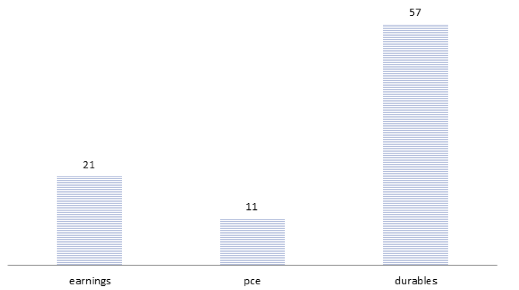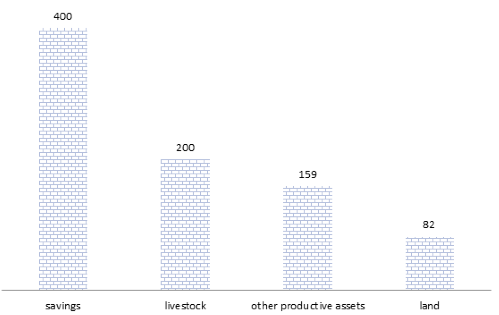
Programme to provide ultra-poor women in Bangladesh with livestock assets suggests one-off interventions can be effective in fighting extreme poverty
Labour is all that the poor have and employing it in a productive way is crucial in enabling their exit from poverty. In this column, we report on results from the evaluation of a programme designed to achieve this goal in Bangladesh – BRAC’s Targeting the Ultra Poor programme (TUP) – also sometimes referred to as a Graduation Programme (Bandiera et al. 2017).
To identify who is eligible for the programme, BRAC asks village residents to rank all households in wealth bins and then targets the poorest women in the bottom wealth group. These women are mostly beneath the global poverty line, they are also almost entirely illiterate and a large fraction of them are the sole earner in their household. These women are also largely landless, lacking livestock and business assets – indeed this is the key feature that differentiates them from the richer women in the village.
Figure 1 reports data from our baseline survey of 21,000 households in 1309 villages. There we see that, across all social classes, women devote 80% of their labour hours to just three labour market activities – maid work, agricultural labour, and livestock rearing. What is even more striking in Figure 1 is that the poor are predominantly engaged in low-return and seasonal casual wage labour, whereas middle-class and rich women are engaged in higher-return and less itinerant livestock rearing.
Figure 1 Occuptation by wealth class at baseline

Note: The figure reports the share of total work hours devoted to each of the three occupations and to a residual ‘other’ category at baseline by all the sample women divided into four wealth classes.
Because of seasonal demand for their labour, ultra-poor women work two months less over the course of a year. This is consistent with evidence from other parts of the developing world that the rural landless poor are often underemployed.
Evaluating the Targeting the Ultra-Poor programme
BRAC’s TUP programme gives women a menu of income-generating assets, all valued at $560 in purchasing power parity terms, from which all participants selected a bundle of livestock assets. The assets are accompanied by a support package of similar value to train and assist recipients in working with livestock over two years.
To evaluate this programme, we ran a large-scale and long-run randomised control trial in Bangladesh covering over 21,000 households in 1,309 villages, surveyed four times (in 2007, 2009, 2011, and 2014). We design our evaluation so that we can look at effects across social classes for a full seven years after the programme is introduced. This allows us to go beyond short-term effects and assess whether the programme indeed achieves its aim of lifting people out of poverty or whether it only provides a short-term boost.
Results
Figures 2 and 3 show that the poorest women in Bangladesh who receive support under the TUP can take on the occupations of their wealthier counterparts and, through this, escape poverty. Four years after the asset transfer, they work 17% more hours and 22% more days per year, as shown in Figure 2. The figure also shows that this is driven by a 217% increase in hours devoted to livestock rearing, while the hours devoted to agricultural labour and maid work both fall.
Figure 2 Four-year effect on hours and days worked (%)

Note: The figure reports the coefficient of treatmentXsurveyAt4Years from a specification that includes treatment, survey dummies, and sub-district fixed effects. The sample is all ultra poor women in treatment and control villages.
Figure 3 Four-year effect on earnings and expenditure (%)

Note: The figure reports the coefficient of treatmentXsurveyAt4Years from a specification that includes treatment, survey dummies, and subdistrict fixed effects. The sample is all ultra poor women in treatment and control villages.
As shown in Figure 3, the earnings of women in the programme after four years are 21% higher, their per capita expenditure is 11% higher, and the value of durable goods they own is 57% higher. There is therefore clear evidence that ultra-poor women in treated villages experienced a very significant improvement in living standards. This is an important finding, in particular because the results in Figure 3 are four years after the baseline, and two years after the programme ended, demonstrating that welfare gains are maintained even without further assistance.
In Figure 4, we examine financial and productive assets, which are what differentiate the poorest women from richer women at the baseline. These effects demonstrate that women are moving from a position of being largely asset-less, with limited participation in financial markets, to one of greater asset ownership and financial inclusion. These effects also indicate that the increase in per capita expenditure will be larger in the long run as the new assets will start yielding income.
Figure 4 Four year effect on asset value (% increase)

Note: the figure reports the coefficient of treatmentXsurveyAt4Years from a specification that includes treatment, survey dummies, and subdistrict fixed effects. The sample is all ultra poor women in treatment and control villages.
There is no doubt that these effects are very large relative to baseline values and relative to ultra-poor women in control villages. They are also larger than those achieved by pilots of the same programme across six different countries and similar to those achieved in neighbouring West Bengal (Banerjee et al. 2015).
Our study design allows us to test whether these gains come at the expense of other households in programme villages who do not receive the programme. We tracked 15,100 households from wealth classes other than the ultra poor and find no evidence that this is the case – the livestock rearing businesses of richer women are not crowded out, and the agricultural and maid wages they receive increase as eligible households withdraw their labour.
Cost-benefit analysis
The ultra-poor programme that we study is expensive. The combined value of the assets, training and support provided is $1,120 per household in purchasing power parity terms. So this is really a ‘big push’ but time-limited programme. Because we know the returns to the programme, we can carry out a cost-benefit analysis. We estimate that the programme’s benefit-to-cost ratio is 3.2 if the estimated consumption benefits in the fourth year are repeated over 20 years. In short, the benefits from the programme far exceed the costs. We also estimate the internal rate of return of the programme to be between 16% and 22% – very high relative to existing market rates. This demonstrates that it would have been worthwhile for households to have invested in these types of activities if they could have afforded to do so. The highly positive benefit-to-cost ratios and internal rates of return underline the fact that this is a highly cost-effective programme.
Long-run effects
To assess whether the one-off asset and skills transfers provided by the programme set the ultra poor on a long-run trajectory out of poverty, we fielded a survey to the same ultra-poor households in 2014, seven years after the programme's implementation. By 2014, every control BRAC branch office had treated some villages within its radius, and 20% of the originally selected beneficiaries were treated overall.
The challenge in identifying the effect of the programme in 2014 is that the selection of the late treated is correlated to the outcome of interest, namely, poverty. We use our quantile treatment effect estimates on the original treated to create counterfactuals of the effect of the programme on the late treated. Figure 5 reports two-, four-, and seven-year effects on household consumption expenditures, household assets, savings, and productive assets, assuming that the effect on the late treated is equal to the median of the treatment effect on the early treated.
Figure 5 Treatment effects at two, four, and seven years


The figure clearly shows that the effects are sustained and we never reject the null that the seven year effects on consumption are equal to the four year effects, thus reinforcing the conclusions of the cost benefit analysis. Overall, while these seven year results must be interpreted with caution as the responses of the original beneficiaries might be an imperfect counterfactual for the responses of the late treated controls, a major difference would be needed to reverse the conclusion that a one-off transfer of assets and skills allows the ultra poor to escape poverty in a sustainable way.
Lessons and questions for future research
This study demonstrates that the programme gives underemployed women a labour market activity that they can engage in across the whole year. This allows them to increase hours worked and earnings. Perhaps more surprisingly, these are not entirely consumed, but rather saved and used to accumulate further assets.
The study opens up a new area of research focused on one-off, ‘big push’ interventions to counter extreme poverty. However, it leaves several questions unanswered. One key question relates to the heterogeneity of effects – while no household is harmed by the programme, some benefit much more than others.
Another key question is why, if the internal rate of return is so much higher than going market rates, the poor do not invest in these activities themselves. This raises fundamental questions about the ultimate causes of poverty traps in these contexts, a topic on which we hope to conduct future research.
Finally, this study only looks at the transfer of assets and skills designed to enable the poor to set up small livestock businesses. Cash might be more effective. We are engaged in another randomised evaluation in the Punjab in Pakistan which compares the effectiveness of cash and asset transfers and look forward to reporting on those results in the near future.
Editor’s Note: This article is based on an IGC project.
References
Bandiera, O, R Burgess, N Das, S Gulesci, I Rasul and M Sulaiman (2017), “Labor Markets and Poverty in Village Economies”, Quarterly Journal of Economics 132(2): 811-870.
Banerjee, A V, E Duflo, N Goldberg, D Karlan, R Osei, W Pariente, J Shapiro, B Thuysbaert and C Udry (2015a) “A Multi-faceted Program Causes Lasting Progress for the Very Poor: Evidence from Six Countries,” Science 348(6236).



